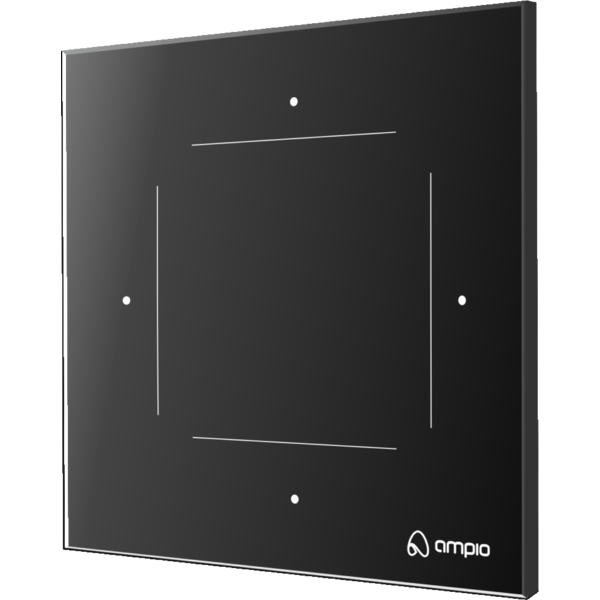
The image above is for illustration purpose only. The actual module may vary from the one presented here.
* The exact dimensions of the module depend on the variant of the glass edge finish selected when placing an order.
Module M-DOT-GEST is a component of the Ampio system. Required voltage to power the module is 11 — 16V DC. The module is controlled via CAN bus.
The module recognises hand gestures made in the proximity of its surface, as well as touch gestures on the glass front. It also has 4 status LEDs and a 1-Wire interface.
The module recognises hand movements over the glass front of the device (it is not necessary to touch it) and, depending on the direction of the movement (up, down, left or right), it can initiate pre-defined actions.
In addition to recognising gestures, the module also responds to touch - it recognises whether the upper, lower, left or right part of the glass front has been pressed.
There are 4 coloured status LEDs on the glass front of the module. They signal which of the gestures has been recognised by the device. At the device configuration stage, it is possible to modify the illumination colour of each LED.
The colour of the module’s front glass and the chamfer width of its edge are subject to personalisation.
The module is equipped with a buzzer that allows one to generate sound signals. Each gesture or panel touching recognised by the device is confirmed by a short beep from the buzzer.
The module is equipped with a 1-Wire interface connector that allows to connect up to 6 digital Dallas DS18B20 temperature sensors. The temperature measurement result is available for all devices operating within the building automation bus. It may turn out to be particularly useful for purposes related to temperature regulation, or to present the measurement result on touch panels and in a mobile application.
The total length of the 1-Wire bus cable to which the temperature sensors are connected cannot exceed 15m.
The panel can be mounted on a surface or it can be flush with the wall surface. Depending on the expected effect, a flush mounting plate or surface mounting frame is used. The frames are available in two variants - for panels with glass with and without chamfered edges.
Both in the case of flush and surface mounting, a standard junction box must be located behind the panel, inside which there will be connectors for the CAN bus and the 1-Wire interface. In the case of flush mounting, the box must be embedded in the wall at a greater than standard depth.
A detailed description of the installation of panels in both variants is available in the appropriate installer guides published on the Ampio knowledge base website.
On the back of the device, there is one red LED indicating the communication status within the CAN bus:
After the device is embedded in the mounting plate or frame, the LED is hidden.
The module is programmed with the use of the Ampio Designer software. It allows you to modify the parameters of the module and define its behaviour in response to signals directly available to the module as well as general information coming from all devices present in the home automation bus.
Dimensions expressed in millimeters.
The panel consist of a glass front and a body with connectors and mechanical interfaces meant for mounting with the use of mounting plates or surface frames. The body is mounted in the center of the rear surface of the glass front with a margin of error appropriate for the production process.
The exact dimensions of the module front depend on the variant of the glass edge finish selected when placing an order.
In the dimensions diagram, the dashed line marks the area where the connectors of the device and its other elements protruding from the body are located. The outline of this area corresponds to the central opening in mounting plates and frames for panels. In the actual module, the CAN bus and 1-Wire interface connectors may be located in a different place than in the figure below, but within the marked area.
Click to enlarge and open in a new tab.
The location of the device connectors on the connection diagram is indicative - in the physical module their location may be different.